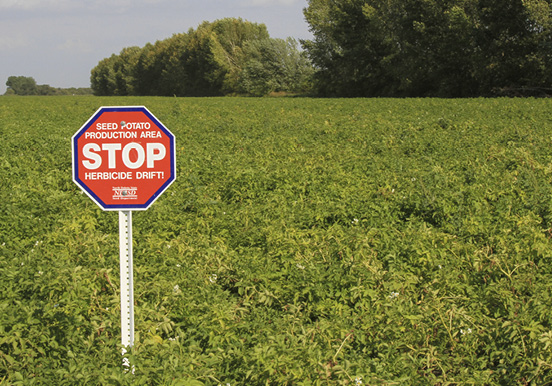Record all possible information related to the suspected drift, such as:
- Date of herbicide application and herbicide/tank-mix information
- Herbicide name and rate
- Date the damage first was observed
- Wind direction, speed and temperature during and following application
- Shifts in wind direction and temperature change after application
- Type of applicator, boom height, nozzle type, spray pressure, nozzle orientation and spray volume
- Crop and herbicide history of the damaged field
Consider all possible causes for observed injury symptoms.
- Consider diseases, insects, nutrient deficiencies, herbicide residue (carryover) and growing conditions.
- Local county Extension staff and agricultural professionals can provide assistance with identification of injury symptoms. Field samples should be well-preserved and represent the range of injury found in the field. Plant diagnostic labs at both North Dakota State University and the University of Minnesota can assist in identification of injury symptoms.
- Consider that drift can result from more than one source and may not be from the closest field. Drift can move one mile or more under some conditions.
- Document injury symptoms from different plant species between the damaged field and the suspected source of drift.
- Several laboratories can analyze plant tissues and soil for herbicide residues. A list of private laboratories is provided in the “North Dakota Weed Control Guide” (W253). Laboratory tests are costly and may not provide a definitive answer because herbicides degrade rapidly in plants and soil, and a single analysis can search for only one herbicide. Also, tests will not determine the drift source or the amount of yield loss caused by the drift.
Make a map of the area.
- Show the relationship of the damaged field to the surrounding fields and indicate crops, herbicide use and dates of herbicide use around the damaged field.
- Show injury patterns in the field and indicate the severity of injury in various areas. Patterns of injury may help identify the source of drift.
Take a large number of high-quality photographs.
- Photograph injury symptoms of foliage and roots of crops and weeds.
- Photographs should show affected portions of plants to illustrate the symptoms. Comparing nonaffected plants and affected plants is useful.
- Aerial photos may indicate the pattern, extent and severity of damage.
- Record the dates pictures were taken.
The first visual evaluation of crop damage from spray drift can overestimate actual damage.
Visual evaluations of crop damage taken too soon after the injury has occurred can be misleading. Crops frequently recover and yield better than expected. The actual extent of crop injury and the proportion of the plants that will die from the injury often cannot be assessed accurately until 15 to 30 days after the damage has occurred.
Use yield loss estimates to predict the extent of damage.
- Visual estimates of yield loss are not reliable.
- Yield from a damaged area of the field should be compared with yield from an undamaged area.
- The comparison should be within the same field because yield comparisons between fields or between years are not reliable.
Promptly contact all parties and insurance companies involved in the drift incident so field visits can be made to validate collected information.
North Dakota law requires that before a civil action is filed seeking reimbursement for property damage, the person must notify the applicator and the person contracting the work by certified mail within 28 days of when the person first knew or should have known of the alleged damage and prior to the time when 20 percent of the crop is harvested. The applicator and up to four representatives can enter the person’s property to observe and examine the alleged damage.
The letter should contain contact information of all parties involved, date of the letter, date the problem was discovered, property impacted, type of damage and legal description of the location. The letter also must state that you are notifying the applicator about the alleged damage under North Dakota Century Code Chapter 4.35.21.3. Invite the applicator to inspect the damage.
Minnesota law does not require filling a notice with the Minnesota Department of Agriculture (MDA) or the applicator(s) to pursue civil action.
The MDA does accept complaints only in writing and reserves the right to pursue or not pursue the complaint if not filed within 45 days of the suspected incident. Contact the Minnesota Pesticide and Fertilizer Management Division at 612-201-6333 for instructions and information.


